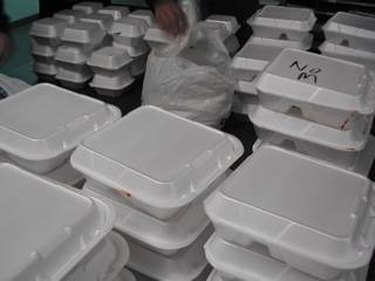
What is Styrofoam?
Styrofoam is the Dow Chemical trademarked name for a chemical compound called extruded polystyrene foam. It has low density, and a poor ability to conduct heat thanks to large pockets of air within its structure. It has been used in many different capacities since its discovery in 1941. Most people will recognize it in the form of foam packing peanuts included in boxes which are shipped to help ensure the contents of the boxes are not damaged in transit. Because of the amount of air in its structure, Styrofoam is considered unsinkable and has been used in life jackets and small inflatable life rafts.
How is Styrofoam Used?
Video of the Day
Styrofoam is made from a petroleum product known as styrene. Through a complex chemical process known as polymerization, the styrene is refined into a clear molten mass of polystyrene. If it were left to cool, it would become a hard plastic. This type of polystyrene is what disposable eating utensils are made of. Before the polystyrene is cooled, an agent which causes polystyrene to expand known as HCFC (Hydrochloroflourocarbon)142b is dissolved into the polystyrene under immense pressure. The molten polystyrene is then extruded or forced through a narrow slot, and then allowed to expand under reduced pressure until it creates foam boards. From there, the boards can be cut into whatever dimensions are required. As a result, the finished product is known as extruded polystyrene foam, or Styrofoam if it was made by Dow Chemical.
Video of the Day
Can Styrofoam Be Safely Disposed of?
Yes, but it's not easy. Being made almost entirely of petroleum products, Styrofoam does not degrade or break down over time. It can be recycled under high pressure, but these recycling stations are wholly underequipped to deal with the amount of Styrofoam that is thrown away across the world each day. Styrofoam can be destroyed if it is incinerated at extremely high temperatures, creating only a small amount of water and carbon as byproducts. However if it is burned in a normal fire instead of in a specialized incinerator, it releases pollutants such as carbon black and carbon monoxide.